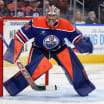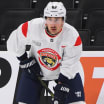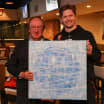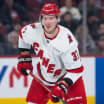Legendary Hockey reporter Stan Fischler writes a weekly scrapbook for NHL.com. Fischler, known as "The Hockey Maven," shares his humor and insight with readers each Wednesday.
This week presents top forward lines from the Original Six (listed alphabetically) and modern eras.
Boston Bruins: Milt Schmidt, Bobby Bauer and Woody Dumart
No offensive unit was more responsible for the Bruins' success from the late
1930s to America's entrance into World War II in 1941 than "The Sauerkraut Line," three friends from Kitchener, Ontario, alternately known as The Sauerkraut, Kraut Line and The Kitchener Kids.
The line debuted Nov. 6, 1937. Their rise to prominence occurred in 1938-39 when they became the engine behind Boston's first Stanley Cup championship in a decade. One season later, Schmidt (52 points) left wing Dumart (43) and right wing Bauer (43) were atop the NHL scoring leaders.
On April 12, 1941, the Bruins defeated the Detroit Red Wings 3-1 to complete a four-game sweep for their second championship in three years.
"We felt if we went in together, asked for the same salary for each, and took a stand in our dealings, we'd be better off," Schmidt said. "When I got married, Woody and Bobby had to toss a coin to decide which one would be my best man."
Chicago Black Hawks: Max Bentley, Doug Bentley and Bill Mosienko
"The Pony Line" thrived because of dazzling footwork and their ability to blend their respective talents like perfectly meshed gears. It jelled prior to the 1945-46 season, after Max finished his three-year Canadian Army stint, when 61 points led the NHL en route to winning the Hart Trophy. A year later, Max again led the League with 72 points, Doug and Mosienko finishing in the top 10.
"By 1945-46 the Pony Line was the NHL's best," historian-author Ty Dilello said.
"At their peak, they even outscored Montreal's outstanding 'Punch Line' of Rocket Richard, Toe Blake and Elmer Lach."
To ensure that his gifted sons and Mosienko remained healthy, farmer Bill Bentley asked Chicago's tough defenseman John Mariucci to "protect" his diminutive sons.
"Bill Bentley even promised to give Johnny a gift if he did a good policing job and Mariucci did, while expecting a $500 reward," wrote Glen Sonmor in his book, "Old-Time Hockey."
Bentley delivered as promised.
"The problem," lamented Mariucci, "was that I expected cash. Poppa Bentley gave me an old cow!"
Detroit Red Wings: Gordie Howe, Ted Lindsay and Sid Abel
Unlike the Ponies, "The Production Line" was physically intimidating. That style meshed with their overall talent and turned the Red Wings into Stanley Cup champions in 1950 and 1952.
The line came into its own in 1949-50, Lindsay's 78 points leading the NHL ahead of Abel (69) and Howe (68). However, a severe head injury sustained during Game 1 of the 1950 Semifinals against the Toronto Maple Leafs nearly ended Howe's career. Thanks to the offense provided by Abel and Lindsay, Detroit won the Cup.
A year later, Howe began dominating NHL scoring. He had 86 points in 70 games in 1950-51, 20 ahead of runner-up Maurice Richard, Abel and Lindsay also among the top 10. Their mastery reached its peak the following season. The Red Wings finished first by 22 points and won the Cup in an eight-game sweep of first Toronto and then Montreal.
"This was my greatest team," said general manager Jack Adams, "and the Production Line was the reason for that."
Montreal Canadiens: Maurice Richard, Henri Richard and Dickie Moore
Starting in 1955, the Original Rocket, his kid brother at center, combined with Moore, a rugged left wing, to help produce the most dominating team of the late 1950s. The Canadiens won the Stanley Cup in five consecutive seasons (1956-60), a record unlikely to be broken.
"The line came together at training camp in '55," coach Toe Blake said. "Henri wasn't supposed to make the team because he was so young, but in every exhibition game he was our best player, so I put him on a line with his brother and Dickie. Henri became 'The Pocket Rocket.'
"The Rocket was our home-run hitter while the Pocket was more the base stealer and opposite-field hitter. Meanwhile, Dickie could do everything, play tough and led the League in scoring two years in a row, '58 and '59. He had the guts to play the second half of '58-'59, wearing a cast to protect a broken hand."
Maurice was regarded as "The Babe Ruth of Hockey" and variously hailed as its most dynamic goal scorer until his retirement in 1960. He was the captain of the Canadiens team that won its fifth straight Cup title and lionized throughout French Canada.
"Maurice was the most exciting athlete I've ever seen," prize-winning author Peter Gzowski said. "So much has been written about Richard that for me to offer a flood of new praise would be roughly equivalent to a Ph. D candidate announcing he's going to prove 'Hamlet' is an interesting play!"
New York Rangers: Bill Cook, Bun Cook and Frank Boucher
"The Bread Line" became an instant sensation in the Rangers' maiden season of 1926-27.
"Bill and 'Bunny' and I clicked as a line from the beginning," wrote Boucher in his autobiography, "When the Rangers Were Young."
A right wing, Bill Cook won the NHL scoring title (37 points) with Boucher at center and kid brother Bun on the right side. It was impossible to talk of Bill without mentioning Bun or their close friend.
"Bill would do most of the talking," Boucher said. "He'd say, 'Now look, guys, when I want that puck, I'll yell for it, and you get that [darn] puck to me. Just put it there and I'll be there.' I knew he'd be cutting in on goal. Then, I'd hear the roar of the crowd and know that he'd banged it in."
Maple Leafs: Joe Primeau, Busher Jackson and Charlie Conacher
Just before Christmas 1929, owner Conn Smythe got a brainstorm and "The Kid Line" made beautiful music.
"I liked the way Conacher and Primeau worked together," Smythe recalled, "and decided to put young Busher Jackson on the line and it made all the difference in the world."
They helped the Maple Leafs to a three-game sweep of the Rangers in the 1932 Final, rallying from down 2-0 in Game 2 with six unanswered goals.
Six favorites from today:
Edmonton Oilers: The inimitable Connor McDavid makes any line better, but it's when he's teamed with the underrated Zach Hyman and old reliable Leon Draisaitl -- or Ryan Nugent-Hopkins -- that Edmonton's "Murderers Row" gives every goalie a case of puck shock.
Florida Panthers: Sam Reinhart and Aleksander Barkov entered last season with something to prove and came away with the Stanley Cup. They were joined by Carter Verhaeghe and at times Evan Rodrigues, superbly combining diligent defense with offense and some heavy hitting as well.
Rangers: Winning the Presidents' Trophy is a Promethean achievement and was accomplished with grand help from Artemi Panarin, Vincent Trocheck and Alexis Lafreniere. All three had NHL career seasons, especially Lafreniere (57 points; 28 goals, 29 assists).
Dallas Stars: The Western Conference's No. 1 seed were energized by
Jason Robertson, Roope Hintz and Joe Pavelski. Though the Stars lacked a single point-per-game player, they eliminated the prior two Cup champs (Colorado Avalanche, Vegas Golden Knights) in the first two rounds. (Too bad the evergreen Pavelski has retired.)
Avalanche: Jonathan Drouin (NHL career-high 56 points) proved a worthy addition next to Nathan MacKinnon (140) and Mikko Rantanen (104). On any given night, MacKinnon could look like the world's best offensive star.
Los Angeles Kings: Quinton Byfield, Anze Kopitar and Adrian Kempe neatly blended a two-way game with special attention to defense. Kopitar, the 36-year-old captain had his second straight season of at least 70 points (75). Kempe (75 points; 28 goals, 47 assists) and Byfield (55 points; 20 goals, 35 assists) were dynamic.


















